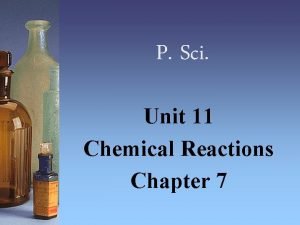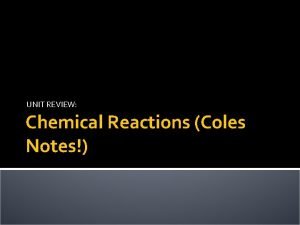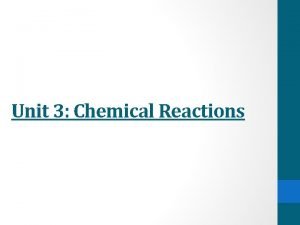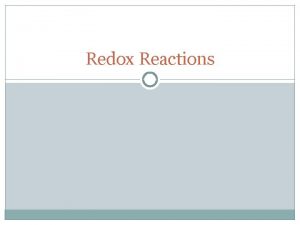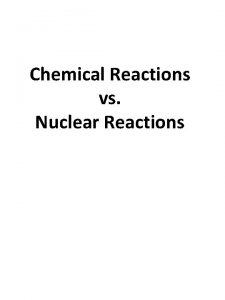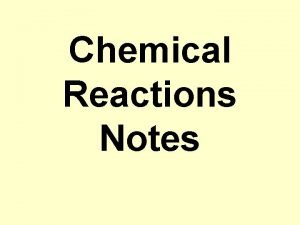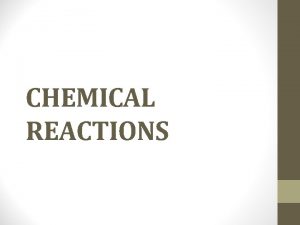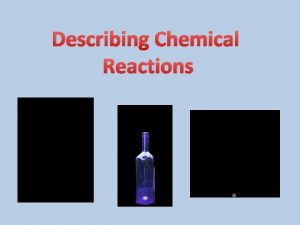CHEMICAL REACTIONS UNIT Notes CHEMICAL REACTIONS Think When





















- Slides: 21

CHEMICAL REACTIONS UNIT Notes

CHEMICAL REACTIONS Think: When you hear the words “Chemical Reactions”, what comes to your mind? Often times, people picture a scientist in a lab working with chemicals. In real life, chemical reactions are taking place all around us when we breathe, eat, when fruit ripens, when we cook, and when plants go through photosynthesis.

CHEMICAL REACTIONS A chemical reaction is a process that results in some chemical change to 1 or more substances. If a substance changes in a way other than a physical change, a chemical reaction must have taken place.

SIGNS THAT A CHEMICAL REACTION HAS TAKEN PLACE 1. 2. 3. 4. 5. Release of a gas Change in color/odor Presence of a precipitate Energy change (heat, light, etc. ) Change of identity of substances

REACTANTS & PRODUCTS Reactants: substances that undergo a chemical change Products: substances that form as a result of a chemical change Reactants → Products *Note: Products and reactants contain the same types of atoms. Remember the law of conservation of mass: Mass cannot be created or destroyed

ENERGY AND CHEMICAL REACTIONS �In order for chemical bonds to be broken, enough energy to overcome the attractive forces of the reactants must be added. �Chemical Energy: the energy stored within atoms and molecules that can be released when a substance reacts �The total energy before a reaction is equal to the total energy after a reaction.

2 TYPES OF REACTIONS IN TERMS OF ENERGY 1. Exothermic Reaction: a chemical reaction that gives off energy in the form of heat 2. Endothermic Reaction: a chemical reaction in which energy is absorbed from the surrounding area.

ENDOTHERMIC VS. EXOTHERMIC http: //app. discoveryeducation. com/search? Ntt=endothermic+ exothermic+reactions https: //www. youtube. com/watch? v=TKcr. Zla. Yv 7 c

CHEMICAL EQUATIONS Chemical Equation: An equation that uses chemical formulas and symbols to show the reactants & products in a reaction. In a chemical equation: the reactants, on the left side of the arrow, form products, on the right side of the arrow. The symbol “→” means “gives” or “yields”

BALANCING CHEMICAL EQUATIONS An equation is balanced when the number of atoms of each element on the right side equals the number of atoms of each element on the left side. A balanced chemical equation follows the Law of Conservation of Mass

RULES FOR BALANCING CHEMICAL EQUATIONS 1. You CANNOT balance an equation by changing the chemical formulas. § You must leave the subscripts in the formulas alone!! 2. An equation can be balanced only by: putting numbers, called coefficients, in front of the chemical formulas. § The coefficients tell how many molecules of that compound are present. 3. The numbers of atoms for each element must be the same on each side of the equation.

STEPS USED TO BALANCE A CHEMICAL EQUATION 1. Determine number of atoms for each element. 2. Pick an element that is not equal on both sides of the equation. 3. Add a coefficient in front of the formula with that element and adjust your counts. 4. Continue adding coefficients to get the same number of atoms of each element on each side.

EXAMPLE #1 Mg + O 2 → Mg. O Mg= O= Whenever you have a coefficient of 1, it is NOT written!!

EXAMPLE #2 Cu. SO 4 + Al → Al 2 (SO 4 ) 3 + Cu

LAW OF CONSERVATION OF MASS The law of conservation of mass is followed in chemical equations: The total mass of the reactants is the same as the total mass of products.

LAW OF DEFINITE PROPORTIONS The law of definite proportions: A compound ALWAYS contains the same elements in the same proportion, regardless of how the compound is made or how much of the compound is formed.

RATES OF CHEMICAL REACTIONS There are 6 factors that affect the rate of chemical reactions: 1. Increase in temperature: Why? The particles are moving faster and have more chances to collide into each other to make a reaction. 2. Increase in Surface area: Why? More of the substance is exposed, so the particles have more opportunities to come into contact with each other. § Examples: crushing, chopping up

RATES OF CHEMICAL REACTIONS 3. Increase in concentration: Why? Increasing the number of particles increases chance of collision resulting in a reaction. 4. Increase in pressure: Why? Particles are squeezed into a smaller volume, so there is less space and more collisions occur between particles.

RATES OF CHEMICAL REACTIONS 5. Nature of the reactants: a. Size and Shape: Why? Heavier particles move slower than lighter particles at the same temperature & have less opportunity to collide with other molecules. b. Nature of reactant: Why? Some molecules must fit together in a certain way in order to react.


RATES OF CHEMICAL REACTIONS 6. Adding a catalyst: A substance that alters the rate of a reaction, but is left unchanged in the reaction. a. Inhibitors: catalysts that slow down reactions. b. Enzymes: biological catalysts that speed up a biochemical reaction.
 Chemical reactions section 2 classifying chemical reactions
Chemical reactions section 2 classifying chemical reactions Chemical reactions section 2 classifying chemical reactions
Chemical reactions section 2 classifying chemical reactions Dream with eyes open
Dream with eyes open Types of reactions
Types of reactions Unit 5 chemical reactions answers
Unit 5 chemical reactions answers Chemical reactions section 1 chemical changes
Chemical reactions section 1 chemical changes Are kc and kp equal
Are kc and kp equal Hcl and sodium hydrogen carbonate
Hcl and sodium hydrogen carbonate Unit 11 chemical reactions
Unit 11 chemical reactions Unit 5 chemical equations and reactions
Unit 5 chemical equations and reactions Basic redox reactions
Basic redox reactions Think said the robin think said the jay
Think said the robin think said the jay Think fam think
Think fam think Unit 10, unit 10 review tests, unit 10 general test
Unit 10, unit 10 review tests, unit 10 general test Wisc
Wisc Stoichiometry island diagram
Stoichiometry island diagram Types of chemical reactions redox
Types of chemical reactions redox Types of reaction
Types of reaction 4 types of chemical reactions
4 types of chemical reactions Types of reactions
Types of reactions Predicting products of chemical reactions
Predicting products of chemical reactions 4 types of chemical reactions
4 types of chemical reactions








